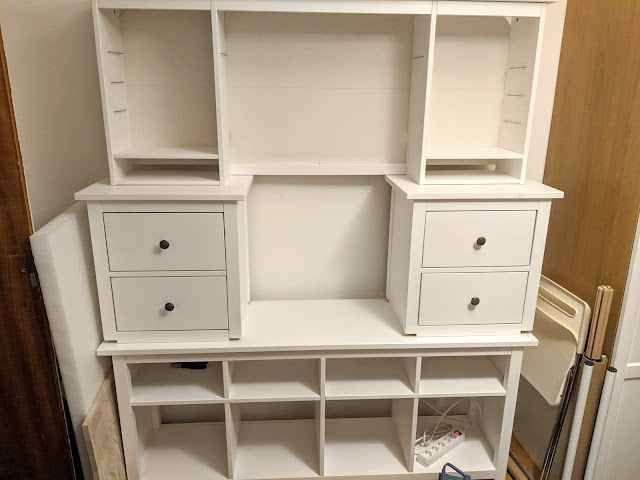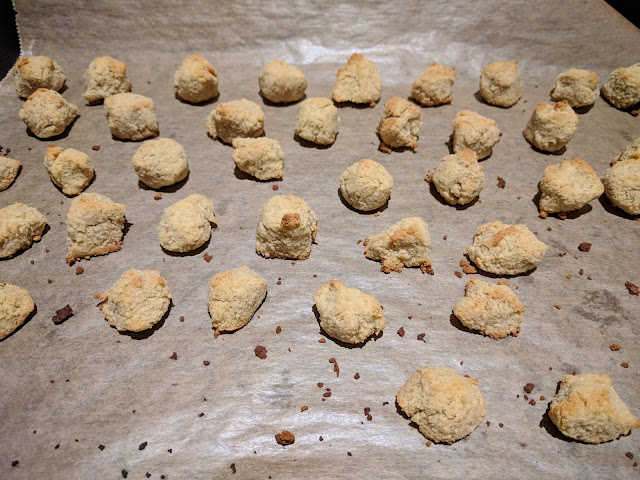A comparison of specialty flours
Since I'd be adding other flours that have their own properties, I reduced the amount of gluten to 10g, and used 25g of each of the other flours. I still went with 100g of water, but this time I used a finer scale to make sure my measurements were much more precise. I also added 1g (a "dash") of salt, to make it potentially edible. I did three batches, because I only have four of the little baking pans, and because I don't want too much delay between the first and last concoction. This was my procedure:
- Measure out the gluten, flour, and salt in each baking pan in advance.
- Gently stir the flours to mix them, using a small whisk.
- For each pan, measure out 100g water in a bowl, then sift in the flour and stir it with a fork.
- Let them stand for half an hour to let the gluten form its plates.
- Put them in a pre-heated oven at 200C.
- Take them out when they're browning.
- Let them cool before cutting into them.
Round 1: Some "common" specialty flours
Almond flour
The most popular low-carb flour. The almond flour mixture was fairly thin, like a pancake batter. It didn't change much during baking, behaving more or less like a pie filling.
Sunflour seed flour ("sunflour")
Sunflour is still fairly new to me, but I at least know not to mix it with baking soda. The sunflour mixture was quite doughy. At the end of the resting period, a bit of water had collected around the sides. Didn't rise very much either
Flaxseed flour
Flaxseed flour is a standby in low-carb cooking. The flaxseed flour mixture was surprisingly sticky and lumpy, and rose a lot in the oven, keeping structure after cooldown. That marks it as a good substitute - it can form a structure that allows bubbles to expand.
Chestnut flour
Found this in a shop, and bought it despite it not having any nutrition information. It turned out to be somewhat high in carbs. Haven't tried using it yet. The chestnut flour was decidedly runny, not even batter-like, but more like water. After resting, there was some liquid on top. Did not really rise at all.
 |
| First batch of flours, with the fine scale (0.01g precision) |
 |
| The flaxseed flour stands out with the amount of rise. The chestnut flour isn't bad either. |
 |
| After cooldown: The flaxseed flour kept its shape nicely. |
 |
| Cut open: All were somewhat moist, but generally had a good structure |
Round 2: Wheat and weird flours
Chickpea flour
Not very low-carb, but we got it anyway. Haven't used it before. Dough was fairly runny, not a lot of rise to it, but at least stayed together afterwards.
White wheat flour
Your standard, average, normal, common, everyday, typical flour. Type 405, to be specific. Dough was runny like a batter, and it rose beautifully, collapsing afterwards.
Whole wheat flour
Wheat with all the bits and pieces. Rose like the white wheat flour and collapsed the same way.
Chia seed flour
I haven't used this before, but chia seeds are known to make a sticky, tapioca-like substance when soaked, so it's interesting what will come of the flour. The result was about as weird as expected: A sticky lump that stayed lumpy, just getting brown on the outside. The inside did not get cooked. Conclusion: Use with extreme care, this is not a direct replacement for anything.
 |
| Second batch. The regular flours were somewhat runny, the chia seed a sticky lump. |
 |
| Cut open: The wheat flours are a bit clammy, the chickpea flour has a pretty nice structure, the chiaseed flour is entirely uncooked on the inside. |
Round 3: Strange and corny flours
Hemp flour
I tried using hemp flour in a cake once, but the greenish color and strong smell has kept me from using it again. It didn't absorb much water, nor did it rise, and the baked product fell apart. Not very useful.
Corn Flour
Not a lot of rise during cooking here, but the result was at least somewhat appealing and had structural integrity.
Sesame flour
This is the first time I've used sesame flour for anything. It's rather coarse, on par with the coarser almond flours. Thus it didn't absorb much water or form structures, just sat there and fell apart.
Coconut flour
Quite popular in gluten-free baking, known to absorb quite a lot of water. The dough was indeed quite firm, but the rise was missing, and the end result was again falling apart.
 |
| Third batch: Hemp flour was very runny, the coconut flour quite dry |
 |
| During baking: Nothing happens! |
 |
| Result of third batch: The corn flour holds its own, the others just fall apart. |
Bonus discovery
I did the first round without any grease in the pans - hey, they're teflon, right? Wrong! Well, they are teflon, but that doesn't mean things don't stick. Getting the pans clean was a nightmare. For the second batch, I used oil, which didn't help very much. The third batch was done with butter, and that was substantially easier to get out and clean. Now of course these flours were all different, but the amount of stuck-ness didn't vary much between each pan in a batch. I'm sticking (pun intended) with butter for greasing.
Conclusion
In short: If a recipe calls for "nut or seed flour" without being more specific, avoid that recipe. These flours each behave in their own very different ways, changing color, taste, structure, rising properties and more. This test is simple compared to doing actual bread or cake, in order to bring out the differences, now I at least have some rough idea of which flours go in what direction.
Substituting wheat flour with other flour is not easy. The wheat flours did a ballooning that only the flaxseed flour could emulate, so I guess I was lucky to hit on the flaxseed flour early on in my process of making balanced bread.





An update after much experimentation: For bread, sunflower seed flower and a bit of psyllium husk (Flohsamenschalen) works well, for cakes almond flour (not Teilentölt) and a bit of coconut flour has been best.
ReplyDelete